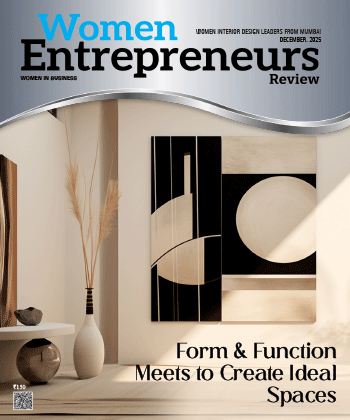
Driving Gender Equity & Inclusive Leadership in Global Total Rewards
By: Neha Gupta, Group Head - Total Rewards, UPL
Neha Gupta is a seasoned HR professional with more than two decades of experience in industries like IT, Logistics, GSCs, Investment Banking, and Agriculture. Being an accomplished business leader, she has worked with global organisations that include Nomura, Lehman Brothers, Maersk, and now UPL as Group Head of Rewards. She is armed with diverse specialisations, including executive compensation, change management, as well as building equitable workplace policies.
In a recent conversation with Women Entrepreneurs Review Magazine, Neha talks about the nuances of women leaders rising the corporate ladder, while sharing personal anecdotes from her professional journey. She shares her outlook on leading rooms that are male-dominated and making invisible labour visible via rewards frameworks while managing the emotional complexities of mergers and acquisitions. Highlighting the significance of authentic leadership, Neha talks about authenticity and owning your stories as key drivers for women’s empowerment in the workplace.
Read the article to know more.
In high-stakes executive compensation conversations across global boardrooms, how do you assert your voice as a woman, especially when the room isn't designed to hear you?
It depends on how you find your voice. It's never easy to enter a room where you're new—you don’t know the people or the culture. In the beginning, it's important to listen and understand the dynamics of the room. The challenge is that many people expect you to make an immediate impact, but that’s not always realistic. First, you need time to absorb, settle in, and feel a sense of belonging before you can truly contribute. Mistakes are costly, and people make quick judgments.
The key is to stay true to your unique self. Often, there's pressure to behave a certain way—sometimes even to emulate male behavior in male-dominated environments. Albeit a woman being assertive can be considered aggressive, and showing emotions can be dramatic. It’s crucial to find your voice and develop your style of leadership. Authenticity is essential. You won’t speak up in every meeting or make an impact in every discussion, and that’s okay. What matters is consistently building your voice, maintaining your dignity, and standing up for what you believe in.
I’ve been in many different rooms—global settings with diverse cultures, and local ones with mostly Indian men. The dynamics vary, but in all cases, finding your voice is essential. It won’t be easy, but with time and experience, you evolve. And having a good mentor can make a big difference.
When linking total rewards to business outcomes, how do you ensure the invisible labor women perform in organizations is made visible, valued, and rewarded?
This is a conversation we've been having for some time. Rewards play an important role in creating an environment where women feel supported, whether through equal pay, leave policies, work-from-home options, or return-to-work programs. It's also about the kind of work you offer, the flexibility, and the safety provided. Ultimately, it's about building a holistic environment.
These conversations need to happen internally: What do we want to offer? How can we attract women and design structured policies to bring them into the workforce? I've worked in male-dominated industries, like Shipping and Manufacturing. In such spaces, it's essential to build infrastructure and frameworks where policies are not necessarily equal but equitable.
It's okay to have different maternity and paternity policies. It's okay to start small—perhaps with shorter return-to-work policies—before scaling up to six or twelve months. What matters is initiating the right conversations and ensuring leadership is committed to driving these changes.
Once you create the right environment, it sets off a domino effect: women join, they stay, and the environment continues to evolve. That sustained effort is key to ensuring more women are in the room and shaping the future. Affirmative action is necessary, and it can be implemented in a phased manner while changing culture and conversations.
You’ve led integrations during M&As—how do you navigate the emotional complexity of change, particularly for women whose roles are often destabilized first in such transitions?
Women, contrary to popular belief, are very open to change. However, the way they react to change is often different from men. I haven’t seen mergers and acquisitions impact men and women differently in a broad sense, but I can share one personal and one professional example.
When I was at Lehman, the company went bankrupt just six months after I joined. I had moved to Mumbai with my husband, and suddenly, there was a lot of instability in our lives. We didn’t know where we stood, and that uncertainty affected us personally. As a woman, I felt a certain weight of responsibility, especially because someone had moved for my career. A rarity in an Indian context. Fortunately, I had a supportive husband who understood the situation. We were also young, with fewer liabilities, so that helped. But there was a sense of being treated differently, subtly, because I was a woman.
Mergers and acquisitions create job and location insecurity for everyone, but they can be particularly destabilizing for women who’ve relocated, often with families or dual-career dynamics. Professionally, the key is change management. The first instinct is to resist disrupting the status quo. It's important to maintain continuity while welcoming new people. In most mergers, even if labelled as such, there’s usually a dominant player. Still, the goal should be integration, not disruption.
One campaign I led was called Coalescence, symbolizing the confluence of rivers moving forward together. That’s how acquisitions should be approached: not as disruptions, but as opportunities to grow together.
Too often, acquisitions are followed by cost-cutting and layoffs. While some of that is necessary, we must remember that the purpose of an acquisition is to gain and integrate skills. Change is always challenging, but with the right messaging and narrative, it can be managed well. Poor communication creates instability, especially for women who are many times not in the top retention list or the rooms making such decisions. Maintaining some continuity and clarity is crucial.
After decades in data-heavy roles, you chose fiction writing. How has storytelling helped you reclaim your narrative as a woman in a field driven by numbers and precision?
I've been in corporate roles for almost 21 years, primarily in data-driven positions. One unique stint was a two-and-a-half-year role as the Chairperson of the Internal Complaints Committee (ICC) under the POSH Act (Prevention of Sexual Harassment). It was a very different profile, but I got into it because both rewards and POSH involve legal aspects.
POSH was a transformative experience. The kinds of cases we encountered couldn’t just be viewed through a legal lens, even though the ICC functions like a civil court. That experience pushed me to consider human behaviors more deeply. I institutionalised free EAP support across the organisation to help people cope with the harassment and address the behavioural and cultural aspects behind such incidents. Unless you address the root cause of primitive mindsets, the outcome won’t change.
Whether I'm designing a rewards program, crafting an HR policy, or conducting a leadership interaction, I always try to understand the rationale behind employee behavior. In rewards, you're constantly connecting business outcomes to people’s behaviors to drive performance. Every reward has a story. Every HR product, policy, or employee experience initiative carries a narrative. Even in change management—like during a merger or acquisition—storytelling is key.
That’s when I realized the link between numbers and narratives. Data tells stories, too. This approach shapes how I work and influences my fiction writing. My book Keepsake tells stories from many perspectives, even the negative characters have shades of grey and a backstory, which makes the reader understand them.
My passion is storytelling, and that passion bridges both my creative and professional lives. I believe this enhances my effectiveness in rewards, which is a skill I've acquired, while storytelling comes naturally to me. Combining the two makes me a distinctive rewards professional.
What systemic blind spots have you noticed in global rewards frameworks that subtly disadvantage women? How have you re-engineered them into catalysts for equity?
The structures are based on market data, and the market, as you know, is dominated by male ratios. Take compensation, for example. When a woman goes on maternity leave, it can take six months to a year. When she returns, there's often a systematic delay in catching up with colleagues who didn’t take a break. She loses about a year of learning and experience in comparison. The compensation increase or bonus is based on the contribution during the year. The stretch is assessed based on your 24/7 availability.
The challenge is: do we penalize her for that time, or do we create a fast-track program to help her reintegrate? Even then, it’s important to consider that she may not be able to accelerate as quickly as others—she’s managing a significant life transition.
We need to create opportunities that uphold professional standards while also recognizing that time away can build other valuable skills and maturity. Flexible discussions are key. While there should be clear parameters, we need to assess skills based on the quality of work, not just hours logged or time spent.
In terms of global mobility, how do we support people who want to continue growing their families or caring for them? In a previous company, we redefined what “family” means. It wasn’t limited to spouse and children—it could include parents, partners, or anyone considered family by the employee. Do we need to relook at the eligibility in our policies according to changing family dynamics?
This kind of inclusive definition supports not just women, but all individuals—men, women, LGBTQ+—in having the freedom to define their families and receive equal support. Creating a neutral, inclusive workplace is a critical step forward.
Having navigated business cycles, continents, and compensation structures, what unspoken rules did you have to unlearn as a woman to truly design rewards that include everyone?
One of the biggest challenges in addressing compensation gaps between men and women is the underrepresentation of women in roles that are traditionally male-dominated and often higher-paying. The conversation shouldn't focus only on compensation differences but also on the kinds of roles women are in. Are we enabling women to take on roles that have historically been held by men?
This is the discussion we need to have whenever we talk about diversity or compensation. Why are we differentiating? Some roles naturally command higher pay due to performance or skill demand. But to have a fair discussion, we need more women represented across all kinds of roles.
During compensation reviews, we share diversity and inclusion data. Often, the data reveals a gap, not because of bias in pay for the same role, but because women are concentrated in lower-paying roles. For example, in most frontline roles, where compensation is generally higher, there tend to be more men than women. So, the key question is: how do we encourage and enable more women to take up such roles and move to the C-suite? Do we support the campus strategy to catch them young and allow them to fast-track internally?
We can’t just adjust salaries to create equity. We must make these roles and work environments more attractive and accessible for women. Digitalization is one avenue—digital sales, for instance, offers different dynamics than traditional field sales and could appeal to more women.
Ultimately, we need to rethink how we structure jobs, how we attract diverse talent, and what we offer them. These are the conversations that truly drive change.
Drawing from your experience, would you like to convey any message or advice to aspiring women leaders?
There are two ways to go about things: one is to continue doing what you're already doing, and the other is to embrace change. For me, every significant step in my journey has involved a major change—be it switching jobs, relocating, or taking on a new challenge.
Passion has driven me to keep raising my hand for the next opportunity. But every time I did, it also stretched me. Moving my family across countries and cities was not easy. Every change was exhausting and challenging, both emotionally and physically.
What helped me was faith—faith that even in the face of impostor syndrome or self-doubt, I could handle what came next. So, my advice is simple: raise your hand. Show up. Do your best. If it's meant to be, it will happen. If not, something else will. But if you don’t step up, the opportunity is lost by default.
So, to all the women out there—raise your hand. Say, "Yes, I can." "Yes, I will do my best." And then do it. Our generation in India is the first to step out of traditional roles in large numbers, working and pushing for equality in the workplace.
We are changing the narrative, setting new examples, and building a better future for our children. We must walk so they can run. Keep raising your hand. Keep challenging the system. That’s how we create lasting change.
Most Viewed
- 1 Women's Health Startup HerMD Closing Doors Amid Industry Challenges
- 2 5 Famous Women in Indian Armed Forces
- 3 Saudi Women No longer Require Male Permission for Clothing Choices, says Prince MbS
- 4 Kolkata Medtech Startup Innovodigm Raises Rs 5.5 Crore Seed Funding Led by IAN Group
- 5 Yamunanagar's Kashish Kalra Honoured after Securing 111th Rank in UPSC Civil Services Exam
- 6 Madurai Appoints Its First Woman Corporation Head
- 7 IAS Vijayalakshmi Bidari Appointed as the new Nagpur Divisional Commissioner
- 8 American Entrepreneur Lucy Guo Overtakes T Swift to become Youngest Female Billionaire
- 9 ICC Women's World Cup 2025 Trophy Showcased at Indore's Holkar Stadium
- 10 Aparna Saxena's Beauty Venture AntiNorm Launches in India
- 11 Vidya Nataraj Co-Founded BlueStone Jewellery & Lifestyle files IPO
- 12 5 Women Freedom Fighters of India
- 13 Dr. G Krishnapriya appointed as CEO for Trichy
- 14 M3M & Sirona Partner to Introduce Menstrual Hygiene Vending Machines in 15 Locations
- 15 Punjab Govt launches SHE Cohort 3.0 Supporting Tech-led Women Startups
- 16 Indian origin Lawyer, Sweena Pannu appointed as the US New Superior Court Judge
- 17 The Aurora Tech Award recognizes 4 Indian Women-led Startups
- 18 Kerala's Republic Day parade featured an all-female tableau
- 19 Manisha Kabbur Becomes Karnataka's First Woman International Karate Coach
- 20 Director K. S. Ravikumar's Daughter Maalica Ravikumar Launches Life Coaching Company 'Evergrowth Academy' for Women
- 21 Leezu's Raises Pre-Seed Funding to Accelerate Growth in Sexual Wellness Industry
- 22 Sattu: Super-easy summer drink for PCOS gut healing
- 23 Swathi Nelabhatla creates Sitha App, India's First Women-Exclusive Gig Platform
- 24 7 Timeless Female Kathak Dancers & their Iconic Legacies
- 25 Meet 7 Iconic Women Architects of Modern India & their Most Impactful Work
- 26 This Woman-led Insuretech Startup is Helping Bridge the Education Financing Gap in India
- 27 Women Leaders Share Lessons Learnt from India Women's WC Win
- 28 5 Enterprising Women Founders Powering Singapore's Tech & Innovation Landscape
- 29 4 Women. 4 Stories. One Vision for Smarter, Stronger Healthcare
- 30 Global Gender Gap Narrows to 68.8%, But Full Equality 123 Years Away: WEF Report 2025
- 31 Changemakers: 7 Women Entrepreneurs Taking the Make in India Movement Forward
- 32 Meet Lucy Guo, The Youngest Self-Made Female Billionaire Disrupting Tech
- 33 How Women are Driving India's Festive Online Shopping Surge






